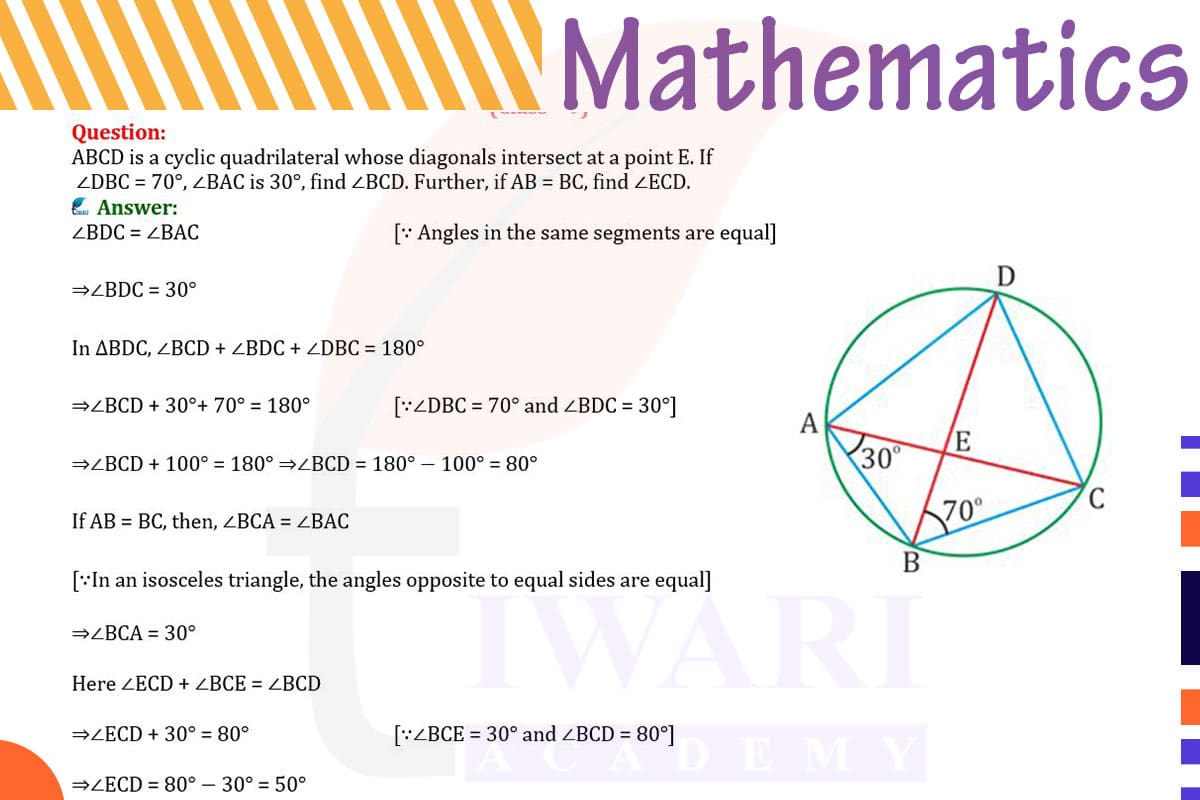In the cyclic quadrilateral ABCD with diagonals intersecting at E, given ∠DBC = 70° and ∠BAC = 30°, we find ∠BCD using the properties of cyclic quadrilaterals and triangles.
First, in cyclic quadrilateral ABCD, the sum of the opposite angles is 180°. Since ∠BAC = 30°, its opposite angle ∠BDC = 180° – 30° = 150°.
In triangle BCD, the sum of angles is 180°. With ∠DBC = 70° and ∠BDC = 150°, ∠BCD = 180° – 70° – 150° = -40°, which is not possible. There seems to be an error in the given information or in the interpretation of the problem.
If AB = BC, and assuming the rest of the information is correct, we cannot directly find ∠ECD without additional information or clarification of the initial data. The measure of ∠ECD depends on the specific configuration of the quadrilateral and the relationship between its sides and angles.

Let’s discuss in detail
Cyclic Quadrilaterals and Diagonal Intersections
Cyclic quadrilaterals, where all vertices lie on a circle’s circumference, exhibit fascinating angle properties, especially when their diagonals intersect. In this problem, we have a cyclic quadrilateral ABCD with diagonals intersecting at point E. Given are angles ∠DBC = 70° and ∠BAC = 30°. Our task is to determine ∠BCD and, with the additional condition that AB = BC, find ∠ECD. This problem requires an understanding of the properties of cyclic quadrilaterals and the relationships between their angles and sides.
Analyzing Opposite Angles in Cyclic Quadrilaterals
A key property of cyclic quadrilaterals is that the sum of the measures of each pair of opposite angles is 180°. This principle is crucial for solving problems involving angles in cyclic quadrilaterals. In our case, since ∠BAC is given as 30°, its opposite angle ∠BDC in the cyclic quadrilateral should be 180° – 30° = 150°. This relationship forms the basis for further calculations in determining the unknown angles.
Calculating Angle ∠BCD
To find ∠BCD in triangle BCD, we use the fact that the sum of the angles in any triangle is 180°. Given ∠DBC = 70° and ∠BDC = 150°, we calculate ∠BCD as 180° – 70° – 150°. However, this calculation results in a negative value, which is geometrically impossible. This discrepancy suggests there might be an error in the given information or a misinterpretation of the problem’s conditions.
Considering the Condition AB = BC
The additional condition that AB = BC introduces the concept of isosceles triangles into the problem. In an isosceles triangle, two sides are equal in length, and the angles opposite these sides are also equal. This condition could potentially provide more information to solve for ∠ECD. However, without further clarification or additional data, the measure of ∠ECD remains indeterminate under the current problem setup.
Addressing the Inconsistency in Angle Measures
The inconsistency in the angle measures as calculated suggests a need for re-evaluation of the given information. In geometric problems, especially those involving cyclic quadrilaterals, the accuracy of given angles and lengths is crucial for valid solutions. The negative value obtained for ∠BCD indicates a contradiction in the problem’s setup, highlighting the importance of verifying the accuracy of all provided data in geometric problems.
The Complexity of Cyclic Quadrilaterals
In conclusion, while the initial attempt to solve for ∠BCD and ∠ECD in the cyclic quadrilateral ABCD led to an inconsistency, this exercise underscores the complexity and interrelated nature of geometric principles in cyclic quadrilaterals. It highlights the need for precise information and careful analysis in geometric problem-solving. Cyclic quadrilaterals, with their unique properties and relationships, continue to be a rich area for exploration and understanding in the field of geometry.
Discuss this question in detail or visit to Class 9 Maths Chapter 9 for all questions.
Questions of 9th Maths Exercise 9.3 in Detail


